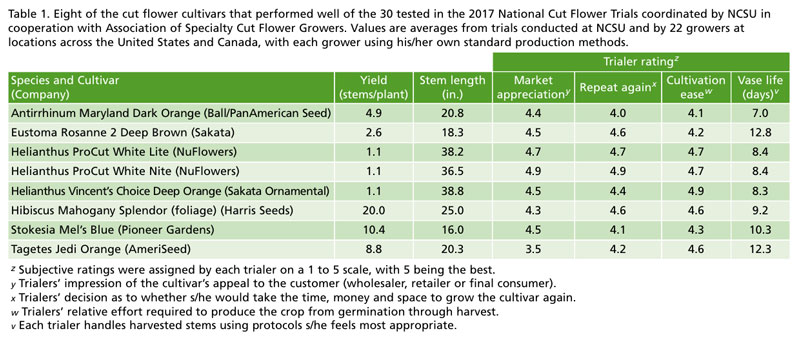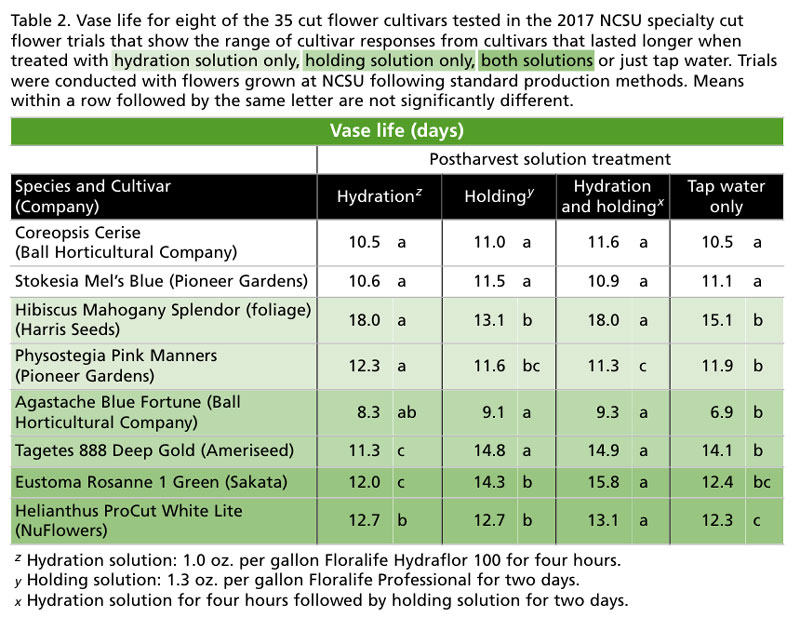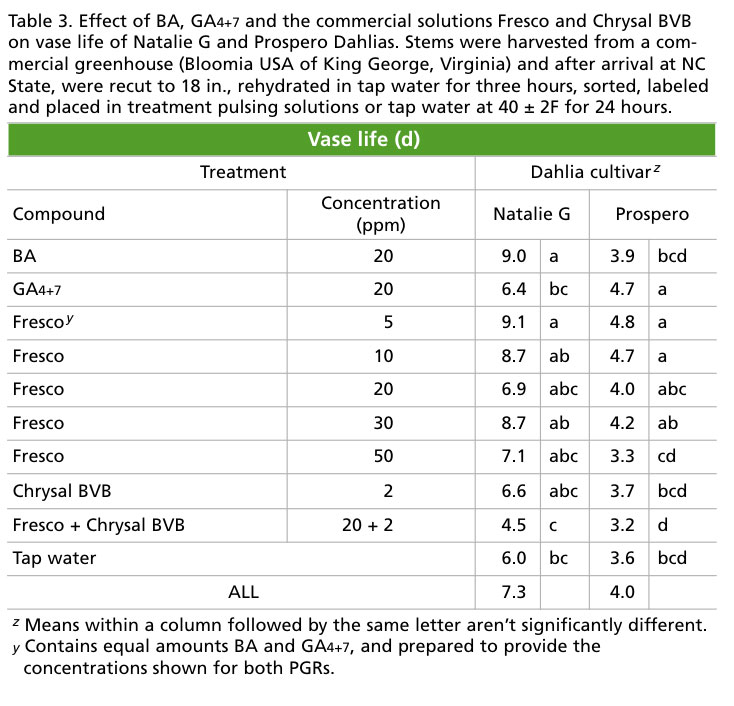6/1/2018
Which Cuts Can Cut it?
Dr. Ben A. Bergmann & Dr. John M. Dole
Cut flowers are hot again, but with a twist. Locally grown flowers, especially those sustainably produced, are in demand. Membership in the Association of Specialty Cut Flower Growers (ASCFG) has sharply increased, especially in regard to Farmer Florists, who design with the flowers they grow.
As part of this increased interest, new and different specialty cut flower cultivars are continually sought by growers, florists and consumers. The North Carolina State University Cut Flowers and Postharvest Floriculture Program plays a role in this quest. Each year, we test newly released cultivars to determine how they perform as cuts and sometimes we delve deeper to look at the postharvest handling of a given species or cultivar.
The NCSU production trials are a part of the ASCFG National Cut Flower Trials. NCSU is not only a trial site, but co-coordinates the multi-state effort with the ASCFG. This collaboration among growers from all over the United States and Canada marked its 25th year milestone in 2017. New cut flower cultivars were grown each of those years to assess the number of saleable stems and stem length, and to determine their commercial marketability and ease of production.
In any given year, the cultivars might be annual or perennial, herbaceous or woody, grown for flowers, foliage or stems, and grown in the field or in a greenhouse or high tunnel. While we generally test a broad range of species, in some years we focus on only one species, e.g., we tested 23 lily cultivars in 2016. The number of cultivars tested in the trials over the last 25 years exceeds 1,200.
Testing vase life
In the 2017 cultivar production trials, we tested 30 annual and seven second-year herbaceous perennials that were grown over a wide geographic area in North America by 32 participating trialers, in addition to our group at NCSU. As always, there were cultivars that stood out as noteworthy successes (Table 1). In particular, ProCut White Nite and ProCut White Lite Sunflowers and the herbaceous perennial Mel’s Blue Stokes’ Aster look like promising new cultivars for growers.
 We conduct postharvest trials each year on the most promising cultivars in the production trials. These experiments have a two-fold purpose: 1) to determine whether a cultivar, no matter how great they look or easy to produce, will last long enough after harvest to be marketable; and 2) to test the effect of hydration and holding solutions (i.e., flower foods and preservatives) on vase life.
We conduct postharvest trials each year on the most promising cultivars in the production trials. These experiments have a two-fold purpose: 1) to determine whether a cultivar, no matter how great they look or easy to produce, will last long enough after harvest to be marketable; and 2) to test the effect of hydration and holding solutions (i.e., flower foods and preservatives) on vase life.
Hydration solutions are applied immediately after harvest as a pulse treatment ranging from a couple to several hours and are intended to facilitate water uptake into the stems. Holding solutions are applied for several hours up to a couple days and they contain sugars as a carbohydrate source to promote bud opening and prolong vase life.
Our standard trials include four treatments: 1) hydration solution for four hours followed by storage in water for two days; 2) hydration in water followed by holding solution for two days; 3) hydration solution for four hours followed by holding solution for two days; and 4) tap water only the entire time as a control. The typical time between field cutting and the start of treatments is less than two hours.
Following postharvest solution treatments, stems are placed one per vase into tap water in environmental conditions that approximate those in a typical home. Vase life is considered to be the number of days until approximately half of the flower(s) or florets (or foliage, buds, fruits or stems in some cultivars) are discolored or wilted. We try to estimate when the average consumer would throw the flower out.
In 2017, we tested 25 annual and 10 perennial cultivars in our vase life trials. As is typically the case, cultivar responses varied greatly, from those with longer vase life only when treated with both hydration and holding solutions to those that benefited from neither solution (Table 2).
For example, cut Mahogany Splendor Hibiscus stems lasted much longer when treated a hydration solution, but not a holding solution. Treatment with both solutions didn’t harm the foliage, but gave no benefit over hydration solution only (Table 2).
 On the other hand, the vase life of 888 Deep Gold Marigold was prolonged significantly with holding solution and did no better or worse by also treating with hydration solution (Table 2). This cultivar was also an example of the rare cases in which vase life is decreased by treatment with one or both of the solutions compared to tap water. In this instance, using just hydration solution alone was detrimental (Table 2).
On the other hand, the vase life of 888 Deep Gold Marigold was prolonged significantly with holding solution and did no better or worse by also treating with hydration solution (Table 2). This cultivar was also an example of the rare cases in which vase life is decreased by treatment with one or both of the solutions compared to tap water. In this instance, using just hydration solution alone was detrimental (Table 2).
We frequently test postharvest practices that are potentially beneficial for a cut flower species or cultivar. For example, we tested the effect of pulses of the plant growth regulators BA (benzyl adenine) and/or GA (gibberellic acid) on the vase life of dahlia, which is very short for this popular flower. We tested several cultivars from local, small-scale growers and one large, commercial grower.
We found that pulsing cut dahlias for 24 hours with PGRs could extend vase life and that the effects of the treatments differed among cultivars (Table 3). Natalie G and Prospero flowers had longer vase life when pulsed with Fresco at 5.0 ppm BA and 5.0 ppm GA4+7 compared to the tap water control flowers. Vase life was lengthened by about a day in the  case of Prospero and by over three days for Natalie G. Interestingly, this positive effect was also observed in Prospero when pulsed with 20 ppm GA4+7 only and in Natalie G when pulsed with 20 ppm BA only.
case of Prospero and by over three days for Natalie G. Interestingly, this positive effect was also observed in Prospero when pulsed with 20 ppm GA4+7 only and in Natalie G when pulsed with 20 ppm BA only.
One of our “just-for-fun” projects was to test the vase life of hardy, day-blooming waterlilies, a spectacular species that’s occasionally used commercially. We saw in preliminary trials over two years that “second-day” flowers had a vase life of just two days, but “first-day” flowers lasted over twice as long. Unopened buds were easier to harvest and handle without damage and lasted as long as first-day flowers, but, unfortunately, didn’t open in some cases. Common postharvest vase solutions actually decreased vase life.
Stay tuned for more on this from doctoral student Nathan Jahnke at some point in the future. GT
Dr. Ben Bergmann is a Research Associate in the Cut Flowers and Postharvest Floriculture Program within the Department of Horticultural Science at NC State University and can be reached at bergmann@ncsu.edu. Dr. John Dole is a Professor and Associate Dean & Director of Academic Programs for the College of Agriculture and Life Sciences at NC State University (jmdole@ncsu.edu).